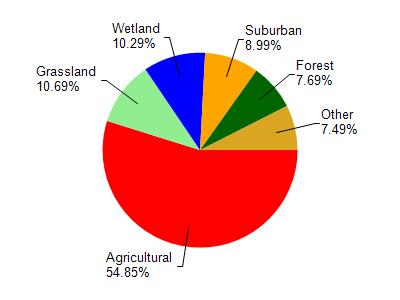Dane
No
No
No
Fish and Aquatic Life
Overview
Leuten Creek is a 3 mile long, spring-fed tributary to the Yahara River, entering below Lake Kegonsa. The creek has a surface area of 2 acres, a gradient of 9.7 feet/mile and a baseflow of 3 cfs. The creek is surrounded by agricultural land with scattered residual wetlands. Although extensive ditching has destroyed most of the original wetlands and has disturbed the remainder, some migrating waterfowl frequent the area. Water quality is below average for the Dane County due to hydrologic modification, and non-point source pollution from cropland erosion. High turbidity and sedimentation have negatively impacted aquatic habitat in the creek. Leuten Creek was managed for trout in the 1950s but supports only a few species of forage fishes.
Date 2002
Author Aquatic Biologist
Historical Description
Leuten Creek -T6N, R11E, Sec. 28, Surface acres = 2, Length = 3 miles, Stream order = II, Gradient = 9.7 ft/mile, Base discharge = 3.0 cfs.
Leuten Creek is a small, spring-fed tributary to the Yahara River, entering below Lake Kegonsa. The watershed consists of agricultural land with scattered residual wetlands. Extensive ditching has destroyed most of the original wetlands and has disturbed the remainder. Some migrating waterfowl frequent the area. Water quality is below average for the county, because of agricultural influences. It was managed for trout in the 1950's but presently supports only a few species of forage fishes. Access is provided at four road crossings and from the Yahara River.
Fish species: no information available.
From: Day Elizabeth A.; Grzebieniak, Gayle P.; Osterby, Kurt M.; and Brynildson, Clifford L., 1985. Lake and Stream Classification Project. Surface Water Inventory of Dane County. Wisconsin Department of Natural Resources, Madison, WI
Date 1985
Author Surface Water Inventory Of Wisconsin
General Condition
Leutens Creek (WBIC 802300) was assessed during the 2018 listing cycle; new temperature sample data were clearly below the 2018 WisCALM listing thresholds for the Fish and Aquatic Life use. This water was meeting this designated use and was not considered impaired.
Date 2017
Author Ashley Beranek
Condition
Wisconsin has over 84,000 miles of streams, 15,000 lakes and milllions of acres of wetlands. Assessing the condition of this vast amount of water is challenging. The state's water monitoring program uses a media-based, cross-program approach to analyze water condition. An updated monitoring strategy (2015-2020) is now available. Compliance with Clean Water Act fishable, swimmable standards are located in the Executive Summary of Water Condition in 2018. See also the 'monitoring and projects' tab.
Reports
Management Goals
Wisconsin's Water Quality Standards provide qualitative and quantitative goals for waters that are protective of Fishable, Swimmable conditions [Learn more]. Waters that do not meet water quality standards are considered impaired and restoration actions are planned and carried out until the water is once again fishable and swimmable
Management goals can include creation or implementation of a Total Maximum Daily Load analysis, a Nine Key Element Plan, or other restoration work, education and outreach and more. If specific recommendations exist for this water, they will be displayed below online.
Monitoring
Monitoring the condition of a river, stream, or lake includes gathering physical, chemical, biological, and habitat data. Comprehensive studies often gather all these parameters in great detail, while lighter assessment events will involve sampling physical, chemical and biological data such as macroinvertebrates. Aquatic macroinvertebrates and fish communities integrate watershed or catchment condition, providing great insight into overall ecosystem health. Chemical and habitat parameters tell researchers more about human induced problems including contaminated runoff, point source dischargers, or habitat issues that foster or limit the potential of aquatic communities to thrive in a given area. Wisconsin's Water Monitoring Strategy was recenty updated.
Grants and Management Projects
| Project Name (Click for Details) | Year Started |
|---|
|
|
Monitoring Projects
| WBIC | Official Waterbody Name | Station ID | Station Name | Earliest Fieldwork Date | Latest Fieldwork Date | View Station | View Data |
|---|
| 802300 | Leutens Creek | 10043100 | Leutens Creek at Spring Rd | 6/5/2014 | 6/23/2025 | Map | Data |
|

Watershed Characteristics
Leutens Creek is located in the Yahara River and Lake Kegonsa watershed which is 126.33 mi². Land use in the watershed is primarily agricultural (54.90%), grassland (10.70%) and a mix of wetland (10.30%) and other uses (24.20%). This watershed has 145.73 stream miles, 3,600.04 lake acres and 6,832.19 wetland acres.
Nonpoint Source Characteristics
This watershed is ranked Medium for runoff impacts on streams, Low for runoff impacts on lakes and High for runoff impacts on groundwater and therefore has an overall rank of High. This value can be used in ranking the watershed or individual waterbodies for grant funding under state and county programs.However, all waters are affected by diffuse pollutant sources regardless of initial water quality. Applications for specific runoff projects under state or county grant programs may be pursued. For more information, go to surface water program grants.